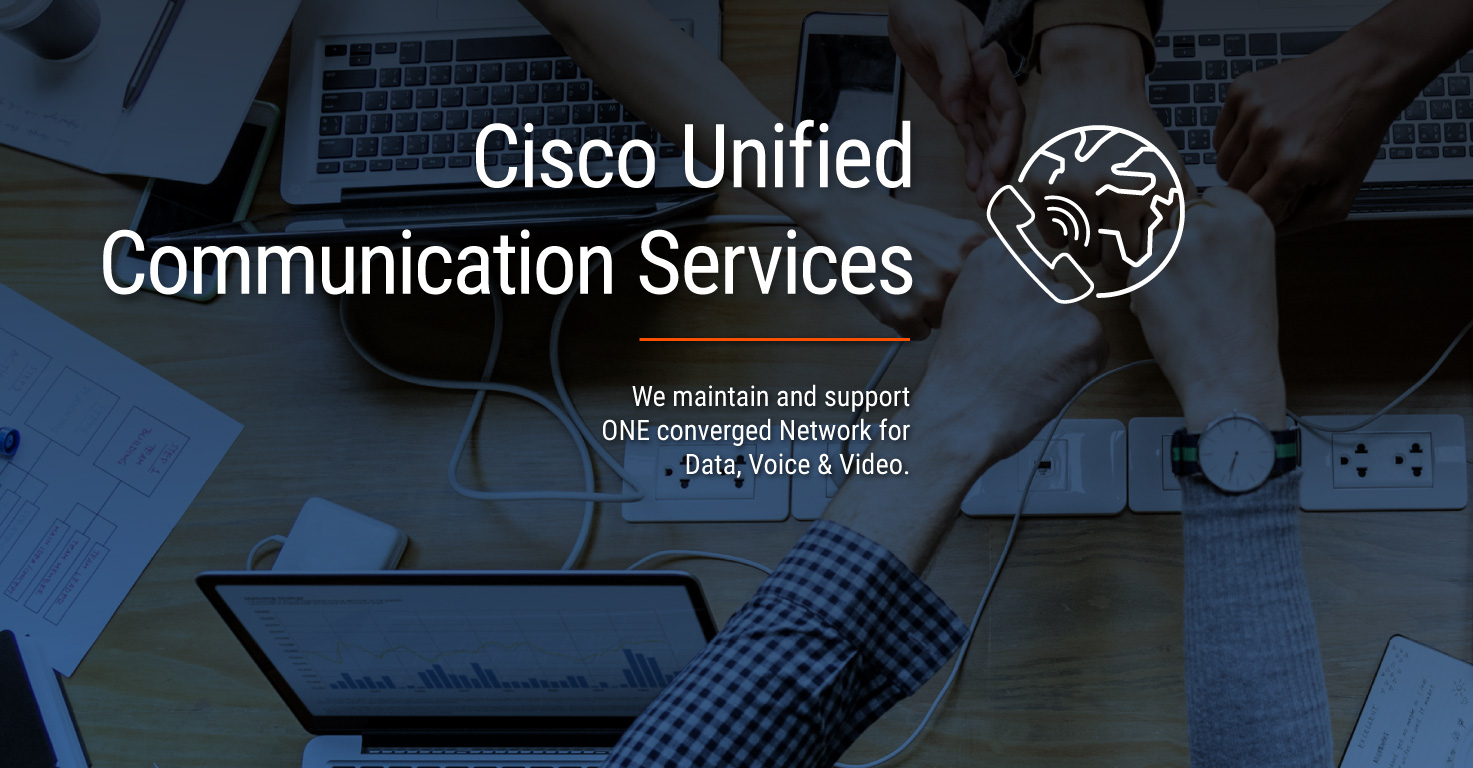BENEFITS OF DEPLOYING CISCO UNIFIED COMMUNICATION
Adoption of Unified Communications continues to accelerate as many businesses and organizations embrace this powerful technology as an essential tool to achieve their corporate goals. It is also evident in the market that legacy PBX systems are reaching the end of their lifecycle (even traditional PBX vendors are moving their solutions to IP Telephony) making Cisco Unified Communications an increasingly advantageous investment.

Enterprises leveraging Cisco Unified Communications solutions can achieve compelling benefits such as:
- Reduction of the Total cost of ownership (TCO)
- Enhancement of business productivity
Lower Total cost of ownership (TCO) is achieved by:
- The architecture of Cisco Unified Communications that provides centralised management and call processing (one IP PBX for numerous sites)
- The ability to integrate with cisco routers in remote sites for backup purposes (no need for extra box in remote sites)
- The ability to integrate telephony services with Corporate Directory
- Easier supplementation of new sites and new features across the entire organisation, relocation of a whole department, and general performance of everyday actions/additions/adjustments.
- Extension Mobility feature – the ability to login on a IPPhone with your full profile (call restrictions, speedials, etc.) that is available everywhere in the enterprise). Extension Mobility can be utilised for shared desk policy and mobile workers (reducing the need for workplaces) and offer significant real-estate savings.
- Reduction of PSTN costs for internal communications. IP Telephony offers VoIP/toll bypass by design, utilising the corporate IP WAN network. There is no need for back-to-back voicecards on PBX and routers or adding hybrid VoIP modules with limited lifetime. Ability to connect natively to VoIP providers for cheaper external calls.
- With the Cisco Unified Communications solution, we maintain and support ONE converged Network for Data, Voice & Video. Cisco’s end-to-end solution offers embedded integration capabilities and collaboration between the data network infrastructure (switches, routers, security devices) and Unified Communications components (IPPhones and Applications)
- Lower cabling costs in case of a new building: IPPhones offer an integrated switch that the user’s PC can be connected to in order to utilise the same UTP cable to connect to Local Area Network.
Transform business and enhance productivity
A very important advantage of the Cisco Unified Communications solution (compared to legacy PBX systems) is that it can be easily and cost-effectively integrated with existing corporate data applications, utilising its CTI/XML capabilities. Application examples are:
- CRM integration (callerID screen pop on the phone or PC, click to dial, duration tracking)
- Directory services (customer/partner or store directories can be accessed from IPPhones, ‘view useful information’ and ‘click to dial’ functions included). For example, a corporate user can be provided with information such as the role, building, letterbox, telephone numbers, email, department, etc.
- Personal directories on the phone (including an option to synchronize with Outlook)
- Integration with 3rd-party clients like MS Outlook and IBM Lotus at the same time.
- Corporate news and announcements on the IPPhone.
- Database queries from IPPhones (for example, inventory checking)
- Ability to schedule conference and meeting rooms from IPPhone.
Examples of such features and applications are:
Videotelephony
Videotelephony (video capabilities integrated with telephony functions) offers enhanced employee communications, reduction of travel expenses and valuable time savings with minimal cost, without the need for user training (a video call can be made exactly the same way as a voice call), minimal administration efforts (same dialplan as voice). Cisco’s solution offers a broad range of videoconferencing endpoints, and also the ability to integrate with existing H323 and H320 solutions.
Unified messaging
Unified Messaging solutions offer the ability to receive voicemail in MS Outlook, Lotus Notes or IMAP client, or even through a webbrowser. Fax integration with Outlook or Lotus Notes can also be provided. Unified Messaging enhances productivity as users can access their messages quickly and regardless of their location.
Mobility services
Teleworkers – users connected to the corporate network through a VPN connection, can utilise softphone applications to keep their telephony services in the same way as at their office desk. Mobile workers, moving frequently around the corporate campus or even across sites, can utilise extension mobility features (described previously), softphones or Wifi phones to maintain full telephony services at any time. Softphones are available for PCs, laptops, pocketsPC, PDAs and even GSM phones. Cisco Unified Communications Applications, Cisco Mobile Connect and Mobility Manager provide integration between the GSM world and enterprise telephony services.
Cisco Mobile Connect offers the ability to extend selected calls coming to a user’s deskphone to ones GSM number (or alternate destinations if desired). The call will ring simultaneously in all destinations (deskphone, mobile, other) so the user, depending on their location, can reply using the preferred device. This significantly enhances user’s reachability through a single (deskphone) number.
The Cisco Mobility Manager offers its users who utilise a GPRS/3G handset the ability to check presence information of their colleagues, chat with them, listen to voicemail messages, and check scheduled conferences calls. In other words, it provides the user with part of their desk functionality while one is out of the office and utilising a GPRS/3G connection.
Text & Audio paging services
Users can send audio or text messages to selected IPPhones (this includes news, announcements, security alerts, etc.). For example, a user can enter a message using their web-browser and send it to all the users of the finance department or all the users on the first floor of building A.
Cisco unified personal communicator client
Cisco Unified Personal Communicator offers softphone, videophone, instant messaging, presence information and preferred method of contact, as well as directory services, access to voicemail, and access to web conferencing services – all from a single application on the user’s PC/laptop. Research states that users increasingly utilize much more videotelephony, IM and web/audio conferencing services when these services can be offered in a user-friendly way. A Personal Communicator user can start a voice conversation, escalate it to a video call or web-conferencing session (being able to share presentations, documents, and invite more participants) by a single button on their client. Integrated messaging and embedded directory access (search for a user, make an audio call, a video call, an IM session or send an email with one click), significantly enhances user productivity. This client is also ideal for mobile workers.
Audio/web/video conferencing services
These services can greatly enhance corporate training processes and collaboration between employees, help reduce time and process inefficiencies in globally distributed processes, and reduce travel expenses. Cisco UC applications offer options for scheduled and ad-hoc audio/web/video conferences, the ability to record a conference call and send it to the the users who could not attend using email.
IP Contact center
Cisco Unified Contact Centers Solutions provide location flexibility (agents over the WAN, PSTN agents, distributed IVR services), enhanced redundancy (primary and secondary callcenter components can be distributed across data centers or different sites), integrated ACD and IVR capabilities (no need for integration of different systems), advanced IP IVR capabilities for voice portals (citizen or customer self service), CTI capabilities for CRM and other corporate applications integration, as well as the ability to easily add video, web, email channels of customer interaction.
Enhanced security – Authentification & encryption
Cisco Unified Communications Solution provides the flexibility to encrypt voice media and signaling, and perform device authentication without the requirement of additional components or solution redesign; offering a secure and reliable UC environment.
